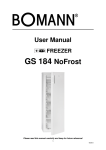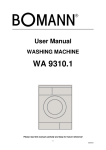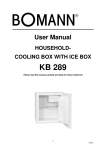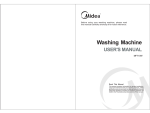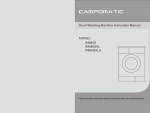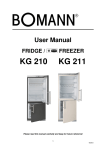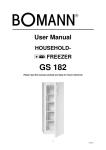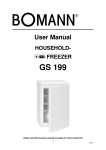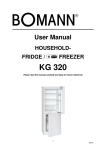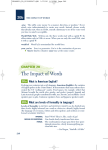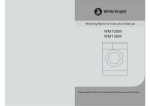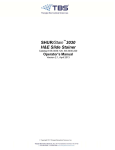Download WA 5612_GB
Transcript
User Manual HOUSEHOLDWASHING MACHINE WA 5612 Please read this manual carefully and keep for future reference! 1 06/2012 TABLE OF CONTENT OVERVIEW IMPORTANT USE AND SAFETY INSTRUCTIONS DISPOSAL OF USED DEVICES PRODUT DESCRIPTION Delivery scope Specifications INSTALLATION Remove the Transit Bolts Location Water Connection Power Connection STARTUP / OPERATION Prior to First Use Control Panel Table of Washing Cycles Start up the Washing Machine End of Washing TIPS FOR SAVING ENERGY MAINTENANCE AND CLEANING Cleaning and care Repairs 2 2 4 5 5 5 6 6 6 6 7 8 8 9 11 12 12 12 12 12 14 OVERVIEW Thank you for choosing this device. This user manual contains important information for installation, operation and maintenance. Please read all instructions carefully, so that you can make use of all functions and the device is kept in good order. The warranty does not cover defects due to overstraining, improper use or maintenance. Please keep all documents in a safe place for future reference. If you have any doubt, please contact your distributor or the nearest authorized specialist. IMPORTANT USE AND SAFETY INSTRUCTIONS All safety information in this user manual are marked with a warning symbol. They indicate possible dangers precociously. It is imperative to read and follow these information. Prevent Electric Shocks - Disassembly, reparation or modification cannot be carried out by people other than professional maintenance staffs. - The household electrical supply system (the current, the voltage, the cable) such as a fuse with suitable specifications should be provided and should meet requirements of the device. - The power plug must be connected to a three-core socket with an earth wire and is grounded properly and reliably. - If the supply cord is damaged, it must be replaced by an authorized specialist or similarly qualified persons in order to avoid a hazard. - Do not disconnect the power plug by pulling the supply cord. Hold the power plug with your hand. - Do not use the supply cord when connection of the power plug and the supply cord is loose. - Do not touch the power plug with wet hands. Wipe dust or water drops over the power plug off with dry cloth in advance. - Do not over-bend the supply cord or put it under heavy weight. - Do not use the supply cord / socket / power plug if it is damaged or broken. Possible Explosions - Do not put combustible liquid such as gasoline, petrol and alcohol into the appliance or nearby. Do not put clothes with that liquid into the appliance. - Do not use flammable cleaning agents or chemicals such as those used for chemical cleanings. - Do not connect / disconnect the power plug when leakage of gas or other combustible gas occurs. 2 06/2012 Fire Danger / Short Circuit or Electric Leakage may occur - Do not install the appliance close to fire sources or heat sources. - Do not rest any burning candles or cigarettes on the appliance. - Do not install the appliances in places with high dampness or extreme wetness, lest igniting damages or other accident occur easily due to gathered water drops on electrical components. - Do not install the device in places under direct sunshine, lest the plastic components and rubber components become aged. - Do not use water shooting at the appliance when cleaning it. Danger of Injury - This machine is not intended for use by persons (including kids) with reduced physical, sensory or mental capabilities, or lack of experience and knowledge, unless they have been given supervision and/or instruction concerning use of the machine by a person responsible for their safety. - Packing materials may be dangerous to the children. Please keep all packing materials (plastic bags, foams etc) far away from the children. - Children and pets must be supervised to ensure that they are not playing with the appliance. They can climb into the washing machine. Check the appliance before use. - Please check whether the water inside the drum has been drained before opening its door. Please do not open the door if there is any water visible. - Glass door may be very hot during the operation. Keep kids and pets far away from the machine during the operation. - The drain pipe will be very hot under high temperatures during washing, resulting in a spin cycle. Be careful and do not burn your hands. General instructions / Intended use - This device is intended for private use. The manufacturer is not reliable for any damage resulting from improper or other then intended use. - For safety reasons, alterations or modifications of the device are prohibited. Use the device only for its intended function. - Any electrical and water connection work required to install this appliance should be carried out by a qualified electrician or competent person. - The appliance is to be connected to the water mains using new hose sets and that old hose-sets should not be reused. - This washing machine is for indoor use only. - Do not climb onto the device or rest heavy objects / heating devices or items with water or liquid leakage on it, lest deformation of the surface and the plastic component occur. - Before operating this machine, transport bolts must be removed from the backside of this machine. Otherwise the washing machine may be seriously damaged while washing (see selection ‘Remove the Transit Bolts’). - After having installed the appliance, check that it is not pressing or standing on its electrical supply cable or water hose. - Before washing the first time, the washing machine shall be operated in one round of the whole procedures without the clothes inside (see section ‘Prior to First Use’). - Do not overload the appliance (see section ‘Table of Washing Cycles’). - Any objects such as coins, safety pins, nails, screws. Stones or any other hard, sharp material can cause extensive damage and must not be placed into the machine. - Inflammable and explosive or toxic solvents are forbidden. Do not use detergents containing gasoline or alcohol. Only use detergents for washing machines. - Do not wash any waterproof items such as raincoats, car sun protection cloth and sleeping bags. - We do not recommend washing carpets. - The drain pump filter has to be cleaned frequently. - After each use unplug the power cord and turn off the water supply after each use. Unpacking Check the device for any possible transport damage. Do not install a damaged device. In case of damage, please contact your distributor. 3 06/2012 DISPOSAL OF USED DEVICES This product is marked in accordance with the European waste regulation 2002 / 96 / EC - WEEE It regulates the proper disposal of the product. Environmentally friendly disposal will prevent possible negative consequences to health caused by improper disposal. This symbol on the product or its packaging indicates that this product must not be disposed of with the regular household waste. The user has to return the product to a collection point for the recycling of electric and electronic equipment. The disposal must comply with the local regulations in place. For further information please contact your local authorities or waste collection service. Disable Waste Equipment before Disposal: - Disconnect the mains plug from the wall socket. - Disconnect the plug from the mains cable. - Remove or disable any existing spring or latch locks. This will prevent children from locking themselves (risk of suffocation!) or from getting into perilous situations. Children might not understand the risks that arise from handling household devices. Therefore, observe children and make sure they do not play with the device. Environmental Protection - Do not use excessive detergents. - Decontaminant and bleacher can be used to pre-treat the stains on the clothes only when very necessary. Packaging Material The packaging for transportation of the device and individual parts is produced of recyclable materials. - corrugated cardboard / paperboard (mainly of waste paper) - form part of PS (foamed, CFC-free polystyrene) - Films and bags of PE (polyethylene) - Strapping strips of PP (polypropylene) IMPORTANT Make sure you dispose of packaging materials environmentally friendly. 4 06/2012 PRODUCT DESCRIPTION IMPORTANT: Unscrew the drain pump filter to let water run out when the machine is not used for a long time. NOTE: The drawings in the manual are only used for instruction. It may be vary from the model you buy. Delivery Scope User manual (D+GB) 4 Transit bolts caps Water inlet hose Hose holder Specifications Model Spin speed Capacity 1) Energy Efficiency Class – Washing Efficiency Class – Spinning Efficiency Class 2) Estimated annual consumption Noise level washing / spinning Connection voltage Connection power Fuse protection Water pressure Power consumption of off-mode Power consumption of left-on mode Unit sizes (HxWxD) Gross / net -weight WA 5612 stop -400 -600 -800 –1.000 –max 1.200 rpm 6 kg A+ – A – B 9.900 l / 177 kWh 60 / 75 dBA 220-240 V / 50 Hz 2.100 W 10 A 0.02 MPa – 0.08 MPa 0.1 W 0.3 W 84.5 x 59.5 x 53.0 cm ca. 68.0 / 64.0 kg Energy-test program in accordance with EU 1061/2010; Annex II: Cotton 60°C/40°C, intensive. With complete filling and partial filling these standard washing cycles are for the data determination on the energy label. These programs are suitable for washing normal soiled laundry and on the combined energy and water consumption at the most efficient. 1) The energy efficiency class is specified according to EU 1061/2010, Annex VI point 1. 2) The weighted annual energy consumption in kWh/year and water consumption in l/year was calculated on the basis of 220 standard washing cycles according to the EU 1061/2010, Annex II. MANUFACTURER DATA: Product is subject to changes and improvements. 5 06/2012 INSTALLATION Remove the Transit Bolts Before using this washing machine, transport bolts must be removed from the backside of this machine. Loosen all bolts with spanner and then remove them and keep the transport bolts properly for future use/transport. Plug the holes with the transit bolts caps supplied. WARNING: Should the bolts aren’t removed, there could be serious damages during operation. Location - - The device must be installed in a clean place, where dirty does not build up. Do not expose the device to direct sunlight. Do not place near heaters, next to a stove or any other heat sources. Avoid installation at locations with high humidity (e.g. outdoors), as metal parts would be susceptible to corrosion under such circumstances. Do not install in rooms where the temperature could drop below freezing. Do not expose the device any weather. Do not place the device near volatile or combustible materials (e.g. gas, fuel, alcohol, paint, etc.). Only place on a steady and safe surface in order to reduce vibration and noise to a minimum. If the ground is evidently uneven (the maximum allowed tilt angle is 2°), it must be balanced, otherwise the unit is wrong, vibrates or moves. If the floor is uneven, adjust the adjustable feet. A good ventilation around the unit is required so the heat can be derived correctly. A distance of approx. 10 cm from the wall is required. The mains plug must be freely accessible. Locknuts Feet Adjustment Take care to a firm and horizontal position of the dryer. If the machine moves adjusts the feet. Loosen the locknuts with a spanner. Adjust the feet: to lower the dryer by turning right and to ascend it by turning left. Tighten the locknut with the spanner after insuring the device is leveled. Once the position is fixed, you need to check the stability. If not, repeat the action till it is leveled. - Adjustable feet NOTE: The locknuts must be tightened after adjustment. Any looseness can cause vibration and noise. The feet must never be removed. Do not restrict the floor clearance through deep pile carpets, strips of wood or similar. This might cause heat build-up which would interfere with the operation of the appliance. Water Connection Install the Water Drain Hose There are two ways to place the end of drain hose: - Hang into a sink or trough. - Connect it to the branch drain pipe of the trough. If the outlet spigot has not been used before, remove any blanking plug that may be in place. Push the drain hose onto the spigot and secure with a clip if required, ensure a loop is formed in the drain hose to prevent waste from the sink entering the washing machine. If you need a drain hose extension, make sure to use a similar drain hose, but it must be no longer than 4 meters; otherwise the washing effect could be reduced. 6 06/2012 It can drain the water up and down, the drain hose shall be installed at a height of min. 60 cm and max. 90 cm about the ground and its end shall not be immersed in water. Please use the supplied hose holder for flexible hoses to get a proper angle and secure it well to avoid a change in position. WARNING: Do not pinched the drain hose and do not place heavy objects on it:, an uncontrolled water flow can cause the machine to stop working. Install the Water Inlet Hose Use the new included inlet hose to connect the machine at the water supply. Old hose-sets should not be reused. Min. inlet water pressure Max. inlet water pressure - 0.02 MPa 0.8 MPa Connect the water supply hose to the tap with a 3/4"thread and tighten it firmly to the right. Connect the other end of the inlet hose to the inlet valve on the back of the device and tighten it firmly to the right too. NOTE: If a leak develops remove the inlet hose and reconnect. Connect to a standard water tap. Power Connection - WARNING: for your personal safety: Do not use an extension cord or an adapter plug with this appliance. Do not, under any circumstances, cut or remove the earth connection from the power cord. Electrical Requirements Please look at the rating label to know the rating voltage and connect the appliance to the appropriate power supply. The voltage is 220-240V. Use the required fuse max. 10 amp. Electrical Connection Ensure the voltage and frequency of the power being corresponds to those on the rating plate. Only insert the plug into an electrical socket which is earthed properly. If the electrical socket to which the appliance must be connected is not appropriate for the plug, let replace the socket by a specialist, rather than using a adaptors or the like as they could cause overheating and burns. Grounding Instructions This appliance must be earthed. In the event of a malfunction or breakdown, earthing will reduce the risk of electric shock by providing a path of least resistance for the electric current. This appliance is equipped with a cord having an equipment-earthing conductor and an earthing plug. The plug must be plugged into an appropriate outlet that is installed and earthed in accordance with all local standards and requirements. - WARNING: Improper connection of the equipment earthing conductor can result in the risk of an electric shock. Check with a qualified electrician if you are in doubt whether the appliance is properly earthed. Do not modify the plug provided with the appliance. If the plug does not fit properly to the outlet, please have a qualified electrician to install a proper outlet. 7 06/2012 - If power cord is damaged or has any sign of being broken, special power cord must be selected or purchased from its manufacturer or service for replacement. Protect the mains cable. Ensure that it does not turn into a trip hazard. The wall outlet must be freely accessible at all times. Do not overload the wall outlet; do not use an extension cable. Overloaded cables can cause fire and electric shock. Do not touch the plug with wet hands. STARTUP / OPERATION Prior to First Use - Make sure the power voltage at your place is same to the rating label at the device. Remove the accessories and any material from the drum. Clean the drum (see ‘Cleaning and Care’) Before using your washing machine for the first time let it run one washing cycle without laundry: - Connect water and power. - Fill a little detergent into the drawer and close it. - Choose the program. - Press the ‘Start/Pause’ button. Preparation of Clothes - Check the pockets of the clothes to be washed, empty the rigid items such as decorations and coins, otherwise washing machine may be damaged or have abnormal troubles. - Sort your laundry before placing it in the washing machine. - Consider the symbols in the washing instructions. Clothes are differentiated in cotton, blended fabric, synthetics, silk, wool and synthetic fibers. - Separate in white and colored laundry. Wash all new clothing separately. - Wash clothes of similar size together for better economy. - Wash delicates separately. New wool fabrics, curtains and silk must be treated like delicates. Observe the washing instructions in all clothes. - Remove hooks from curtains. - Decorations on clothes can damage your washing machine. Turn buttons and embroidery inside out. - Close zippers, buttons and hooks. Tie bands and ribbons together. - We recommend placing for instance bras inside a pillowcase to prevent damage. - Delicate textiles such as laced curtains, straightjackets, small articles (tight socks, handkerchiefs, ties etc.) shall be put into string bag for washing. - Washing large and heavy parts such as bath towels, jeans, lined jackets and the like can cause the drum to run unbalanced. We recommend adding one or two smaller parts; this especially helps with the spinning cycle. - The clothes which easily get fuzzed shall be washed separately; otherwise the other articles can be stained with dust and thrum etc. Preferably, black clothes and cotton clothes shall be washed separately because they can easily get stained with the thrums of other colors when being washed together. - Clean away dusts, stains and pet hairs from the clothes. Please pay Attention with Regard to Detergents - Use only “slightly foaming” detergent for washing machines according to type of fabric (cotton, synthetics, lined or woolen products), color, washing temperature and degree of soiling. Otherwise foaming can cause overflowing. - Bleach is alkaline and can damage your clothing, preferably do not use bleach. - Detergents often leave residue in the clothes, which can cause bad odor if not rinsed properly. - Detergent can not easily get dissolved completely if there is too much detergent or water temperature is rather low. It can remain in clothes, pipes and washing machines to pollute the clothes. Washing shall follow the weight of clothes, dirty degrees, local water hardness as well as the recommendations from the detergent manufacturers. Please consult the water company if you are not clear of water hardness. ATTENTION: Keep detergents and additives in safe and dry places out of touch by kids. 8 06/2012 Detergent Drawer - Pull the drawer out. - Full fill the main wash detergent (we recommend concentrated detergent with less or no bubble formation) in the dispenser 1 market with . - Add the fabric softener into the compartment 2 market with . Do not exceed the maximum level mark. . - Full fill the detergent into the pre-wash dispenser 3 market with - Close the drawer. - NOTE: The dispenser is suitable for the use of washing powder only in the pre- and main- wash cycle! To avoid overflowing dissolve your washing powder in a bit of water in case it is clotted. Clothing, which are not suitable for the Washing Machine: - Ties, waistcoats, outerwear, etc. can shrink. - Colored clothes can discolor. - Pleated clothes, embossed or synthetic fibers can also shrink. Cotton and wool, silk and fur can shrink and crease; - Ornamented evening attire and traditional clothing easily discolors. - Do not wash clothes without washing instructions. - Washing machine shall not wash water-proof materials (ski suits, outside napkin pads, curtains): As for the fiber products that water can not get soaked easily into such as water-proof cushions, and clothes, it is better not to wash. Otherwise there will be water bursting out or abnormal vibration to cause danger while rinsing and draining so that the clothes also may be damaged. ATTENTION: Do not wash clothes soaked in petrol, thinners, alcohol or solvents. Fill in the Laundry - Unravel the clothes before putting them into the machine. - Each loading should correspond to the rated capacity of the machine. Do not overload the machine. - Different strengths / sizes / types of laundry can affect the actual loading capacity of the machine. It is advisable to load the machine with only the amount of clothes that normal circulation is possible during washing. - Make sure that no laundries are caught between the door and the seal. NOTE: The machine is fitted with a balance control device, which ensures the machine is stable during the spin. To protect the machine, it will cut in if the laundry is not evenly distributed in the drum. The laundry is redistributed by reverse rotation of the drum. This may happen several times before the unbalance disappears and normal spinning can resume. Control Panel 1 2 3 4 5 6 1. Spin speed By pressing this button repeatedly you choose the spin speed. 2. Temperature By pressing this button repeatedly you choose the temperature. 3. Start delay By pressing this button repeatedly you can delay the program start by 1-24h. 9 06/2012 4. Functions By pressing this button repeatedly you choose three basic and two combined functions. 'ECO', 'Anti-Crease', 'Rinse+', 'ECO + Anti-Crease' and ‘Anti-Crease + Rinse+’ ECO This function is to reduce energy and water consumption when washing a smaller load. The function is not available on all programs (see ‘Table of Washing Programs’). Anti-crease This function is to reduce the wrinkle of clothes during a wash cycle. Once this function is selected, the machine will not execute the last drain unless the ‘Start/Pause’ button is pressed. This function is available on all programs except spin (see ‘Table of Washing Programs’). Note: The max running time of this function is 12 hours. If it exceeds 12 hours, the machine will drain and spin automatically. Rinse+ This function is to add an extra rinse on the program you selected. This function is available on all programs except spin program. 5. Start/Pause Press this button to start or pause a wash cycle. The door is locked during the program cycle and by pressing the ‘Start/Pause’ button again the door cannot be opened when the temperature inside the drum is above 53°C or the water is above a certain level. 6. Program selector knob Turn this knob clockwise or anticlockwise to select the required wash program. You can find the details of the programs below the ‘Table of Washing Programs’. Note: At the end of a wash cycle the knob must be turned to the position ‘Aus’ (Off). ATTENTION: For your safety, please not turn the knob to the position ‘Aus’ (Off) and get clothes while the machine is running. Because the temperature of water may be high and it may scald you. The door lock will open automatically at the end of a wash cycle while the temperature of the drum is cool down. LCD-Display - During the program cycle the points between hour and minutes flashes. - The delay time is indicated, if set. The program starts after [xx] hours. - After the program has started the remaining washing time is displayed as [xxx] hours and minutes. - Is the child lock activated a symbol With locked door a key symbol expires. is displayed. is indicated; the door can only be opened after the indication Child lock The appliance is equipped with a child lock function to avoid operating errors caused by playing children. Hold the button ‘start delay’ and the ‘function button’ before or during the operation for a few seconds to lock the functions of the buttons and the program selector knob. Press these buttons for a few seconds again to deactivate the child lock. When activated the child lock a symbol in the display is indicated and delete with deactivation. Bubble Self-checking Function Redundant bubbles will occur when there is excessive detergent, which will affect Wash and Rinse effects. The procedure will check automatically and one bubble removal procedure will be added automatically to remove bubbles when excessive bubbles are checked. It will also remind the user to use less detergent during the next similar washes. 10 06/2012 Table of Washing Cycles Below listed values are approximate values with standard conditions and therefore not binding. Program kg Time (min) 99/110/209/219/151 0/400/600/800/1000/1200 94/105/204/214/146 0/400/600/800/1000/1200 69/80/179/189/121 6 6 Cold/30/40/60/95 Available Functions AntiRinse+ creasing ECO 6 Cotton Inten- Cold/30/40/60/95 Cotton Pre-wash Spin speed (rpm) Standard cotton Cold/30/40/60/95 sive 0/400/600/800/1000/1200 Anti-Bac. 95 3.5 129 0/400/600/800/1000/1200 Kids wear Cold/30/40/60 3.5 89/109/99/119 0/400/600/800/1000/1200 Heavy Drum clean Cold/30/40/60 6 86/106/96/116 0/400/600/800/1000/1200 Cold/30/40/60/95 ― 47/49/55/72/97 0/400/600/800/1000/1200 Spin Cold 6 0/400/600/800/1000/1200 11 Synthetic Cold/30/40/60 3 39/59/49/69 0/400/600/800 Wool Cold/30/40 2 38/48/56 0/400/600 Cold/30/40 2 38/46/48 0/400/600 Silk Mix Quick Night wash Rinse+Spin - Temperature °C Cold/30/40/60 3.5 50/70/60/80 0/400/600/800 Cold/30/40 1.5 15/20/26 0/400/600/800/1000/1200 Cold/30/40/60 4 71/91/81/101 0/400/600/800 Cold 6 16 0/400/600/800/1000/1200 NOTE: The functions 'ECO' and 'Rinse+' can not be selected together. The function ‘Start delay’ is available with all programs. Select the Program Program Standard cotton Cotton Intensive Cotton Pre-wash Anti-Bac. Kids wear Heavy Drum clean Spin Synthetic Wool Silk Delicate Mix Quick Night wash Rinse+Spin Explanation You can select this procedure to wash the daily washable clothes. The washing period is quite long. It is recommended to wash the daily cotton articles, for example: bed sheets, quilt covers, pillowcases, gowns, underwear etc. For better results the main wash cycle is extended. This washing program is recommended for baby clothes or persons with allergies. An additional washing cycle for better results is added before the main washing cycle. This function is using 90°C to antibacterial protect people's health. The amount of water is increased. The children’s wear function protects the skin of your baby. Washing with heavy stuff like jeans, bedsheet, bedspread or curtain and so on. This cycle is specially set in this machine to clean the drum and tube. When this procedure is performed, the clothes or other washing cannot be added. When proper amount of chlorine bleaching agent is put in, the barrel cleaning effect will be better. Use this procedure regularly. Separate spin procedure. Soap water or rinse water shall be drained out before spinning. You can select this procedure to wash the quite delicate clothes. The procedure is shorter compared with that for cottons and the washing intension is quite gentle. It is recommended to wash synthetic articles, for example: shirts, coats, blending. As for curtains and laced textiles the procedure synthetic 40°C shall be selected. While washing the knitting textiles, detergent quantity shall be reduced due to its loose string construction and easily forming bubbles. You can select this procedure to wash the wool textiles labeled with “Machine wash”. Please select the proper washing temperature according to the label on the articles to be washed. Furthermore, the proper detergent shall be selected for wool textiles. Specially for the high-quality clothes like silk, it wash softly to reduce attrition. Select this washing cycle for delicates. This washing program is gentler and the spinning revolutions must be lowered than with synthetic. This program allows you put any kind material of clothes wash together, this program has the appropriate washing time and washing intension, not too strong also not too soft. This procedure is suitable for washing few and not very dirty clothes quickly. This function is for people washing their clothes at night. In this program will not have the spin section. It is because to avoid cause noise at the night. The last spin step will decide and control by the user to compete. Separate rinse program with spinning cycle. Do not add any detergent. 11 06/2012 The proper washing procedures shall be selected according to the types, quantities and dirtiness of the clothes to be washed in combination with the following washing temperature table. 90°C 60°C 40°C, 30°C, cold Seriously besmirched, pure white cotton or flax (for example: coffee, table cloths, canteen table cloths, towels, bed sheets). Moderately besmirched, colorful flax, cotton and synthetic articles with certain decolorizing degree (for example: shirts, night pajamas; slightly besmirched, pure white flax (for example: underwear). Normally besmirched articles (incl. Synthetic and wool). Select the washing program and temperature according to the fabrics and soiling degree. Generally applies: as higher the temperature setting, as higher the energy consumption. Start up the Washing Machine - Connect the power. Check if water pipes are connected properly. Open the tap completely. Put in the clothes to be washed and fill in the detergent. Select the proper program and functions and press the ‘Start/Pause’ button. Door Lock Once you started a wash cycle the door cannot be opened. By pausing the operation the door cannot be opened when the temperature inside the drum is above 53°C or the water is above a certain level. When the washing cycle is finished, the door lock will be unlocked after two minutes and the key symbol will not flash on the display. Change the Washing Cylce You have two options to change a running program: - Press the ‘Start/Pause’ button, change the program and press ‘Start/Pause’ again. After several minutes the program will change. - Set the program selector to the position ‘Aus’ (Off). Then you can select another program and restart the device immediately by pressing the ‘Start/Pause’ button. End of Washing When washing cycle is finished, you hear a short melody, the machine will change to a standby status and the power will be off after 10 minutes without any control on the control panel. Turn Off the Washing Machine - Turn off the device by positioning the program selector knob to position ‘Aus’ (Off). - Close the water supply! TIPS FOR ENERGY SAVING To save energy and to help protect the environment, we recommend that you follow these tips: - Do not select the high temperature program casually. - Select the washing program according to the type of laundry and the required degree of washing. - Clean the filters regularly to avoid excessive washing times and high electricity consumption. - Ventilate the room well. The room temperature should not exceed +35°C. MAINTENANCE AND CLEANING Care and Cleaning - CAUTION You must disconnect the appliance from the electricity supply, before you can carry out any cleaning or maintenance work. Do not uses steam cleaners for cleaning the device; moisture could enter electrical components. Risk of electric shock! Hot steam could damage the plastic parts. The device must be dry before restarting operation. Essential oils and organic solvents, such as the juice of lemon or orange skin, butanoic-acid or cleaning agents containing acetic acid can damage plastic parts. Prevent contact of any part with such substances. Do not use abrasive cleaning agents. Cleaning the Exterior 12 06/2012 Proper maintenance on the washing machine can extend its working life. The surface can be cleaned with diluted non-abrasive neutral detergents when necessary. If there is any water overflow, use the wet cloth to wipe it off immediately. No sharp items are allowed to strike the cabinet. Please note: formic acid and its diluted solvents or equivalent are forbidden. Cleaning the Door/Drum Clean the inside of the door and the drum regularly, you can do like that: - Clean with a cloth to remove dirt or fiber residues. - Choose the program “Drum Clean” without any clothes inside, it can clean the drum by itself. Cleaning the Gasket Fiber residues in the sealing ring can lead to a loss of water. Therefore remove fiber residues and other textiles. Clean detergent drawer and its housing - Press down on the release catch and at the same time pull the drawer right out of the machine and take out the drawer, wash all guides carefully with water. - Use a bottle brush to remove detergent residues inside the drawer housing. - Replace the drawer. Clean the Water Inlet Filter The inlet filter should be cleaned every 1 - 3 months. - Close the tap. - Unscrew the water inlet hose. - Clean the filter with a small brush. - Install the water inlet hose firmly again, open the tap and make sure that no water drips from the hose. Cleaning the Drain Pump Filter, Remove Foreign Bodies The foreign body trap in the drain pump prevents that rinsed parts blocks the drain pump system. Clean the trap periodically to ensure the normal operation of washing machine. Check the foreign body trap if the water in the wash cycle will not drain or increased noise can be heard during the pumping. CAUTION: First, drain the water and then open the trap to clean away foreign bodies. Take care if the drained water is hot. 1. After the power is disconnected, open the lower cover plate. 2. Turn the fastener of the trap to the left. Look for water leaks! 3. Remove the filter and clean it from any foreign body. 4. Reattach the filter again and look for a tight fit so that no water can escape. Close the bottom cover plate. ATTENTION: Never operate the appliance without filter. Cold conditions 13 06/2012 - Close the tap. If the water inlet hose is frozen, wrap the hose connection with a hot-towel. Remove the inlet hose and soak it in warm water. Full fill the drum with 2-3 l of warm water. Wait a few minutes, until the water has melted, then plug the cord in and select the program 'spin' and restart the machine. Make sure in future that the room temperature is above 0°C. Repairs CAUTION Servicing of electric devices must be conducted by qualified experts only. Incorrect or improper repairs constitute a risk for the user and will void the warranty! What if . . . Troubleshooting Certain problems are due to lack of simple maintenance or oversights. Before contacting your local Service-Centre, please carry out the checks listed below. Problem No water inlet (Error code E1) Door lock alarm (Error code E2) No water outlet (Error code E3) Water overflow water sensor (Error code E4) / The motor does not work (Error code E5) Problem with heating element (Error code E6) Temperature sensor fault (Error Code E7) Possible Cause - Is the water tap open or not enough water pressure? - Is the drain hose plugged in? - Is the sensor defective or is a hose leaking? - The drain valve is defective. - The circuit board is defective. - Is the door properly closed? - Is the laundry caught between door and seal? - The door lock is damaged. - The circuit board is defective. - Is the filter clogged? - Is the drain hose clogged or kinked. - The valve is defective. - Is the plug connected correctly or is it a line fault? - The water sensor is defective. - The circuit board is defective. - The inlet valve is defective. - Are the hoses connected correctly? - The water sensor is defective. - The circuit board is defective. - The connection between the motor and wire is not secure. - The motor is over-heated. - The motor is defective. - The circuit board is defective. - The connection of the heating is wrong or defective. - The heating element is defective. - The circuit board is defective. - The connection of the temperature sensor is wrong or defective. - The sensor is defective. - The circuit board is defective. Solutions - Check the tap and the water pressure. - Install the drain hose. - Check the water sensor and the hose, change if necessary. - Contact a specialist. - Contact a specialist. - Close the door well. - Pull the laundry into the drum. - Contact a specialist. Contact a specialist. Clean the filter. Clean and check the hose. Contact a specialist. Check the plug or contact a specialist. Contact a specialist. Contact a specialist. Contact a specialist. Check the hose connections. Contact a specialist. Contact a specialist. - Contact a specialist. - Contact a specialist. - Contact a specialist. Are you interested in other Bomann products? Please visit our website: www.bomann.de Distribution: C. Bomann GmbH • Heinrich-Horten-Str. 17 • D-47906 Kempen 14 06/2012














